Development and Validation of a Wear Model to Predict Polyethylene Wear in a Total Knee Arthroplasty: A Finite Element Analysis
Abstract
:1. Introduction
2. Materials and Methods
2.1. Roll-on-Plane: Experimental
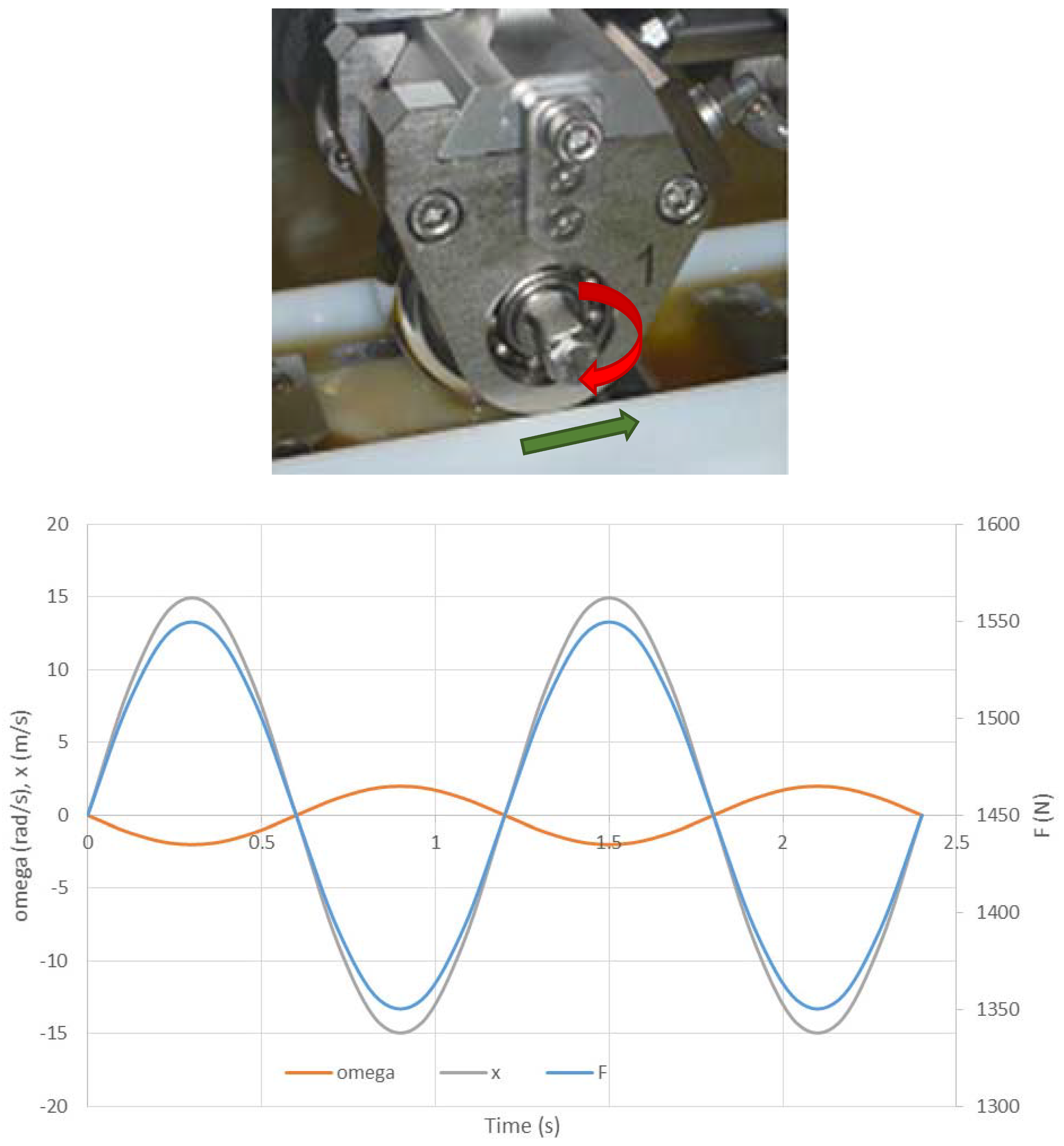
2.2. Roll-on-Plane: Numerical Wear Model
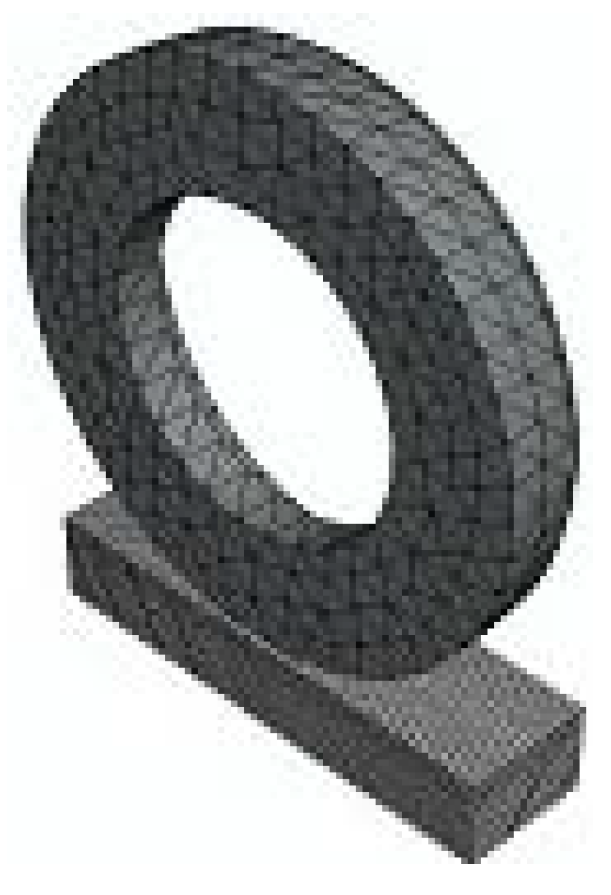
2.3. Wear Model
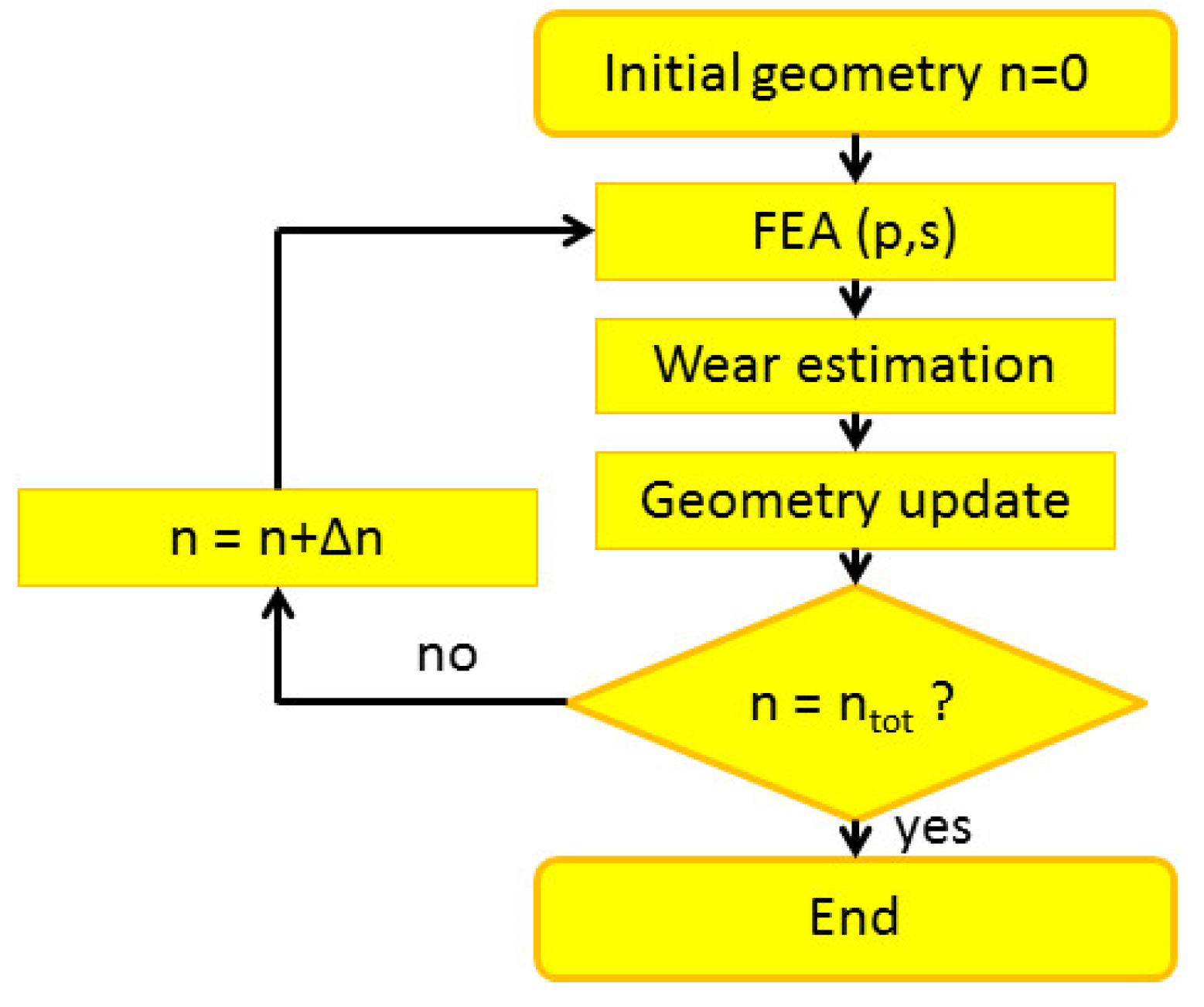
2.4. Roll-on-Plane Calibration
2.5. Experimental Patello-Femoral Wear Tests

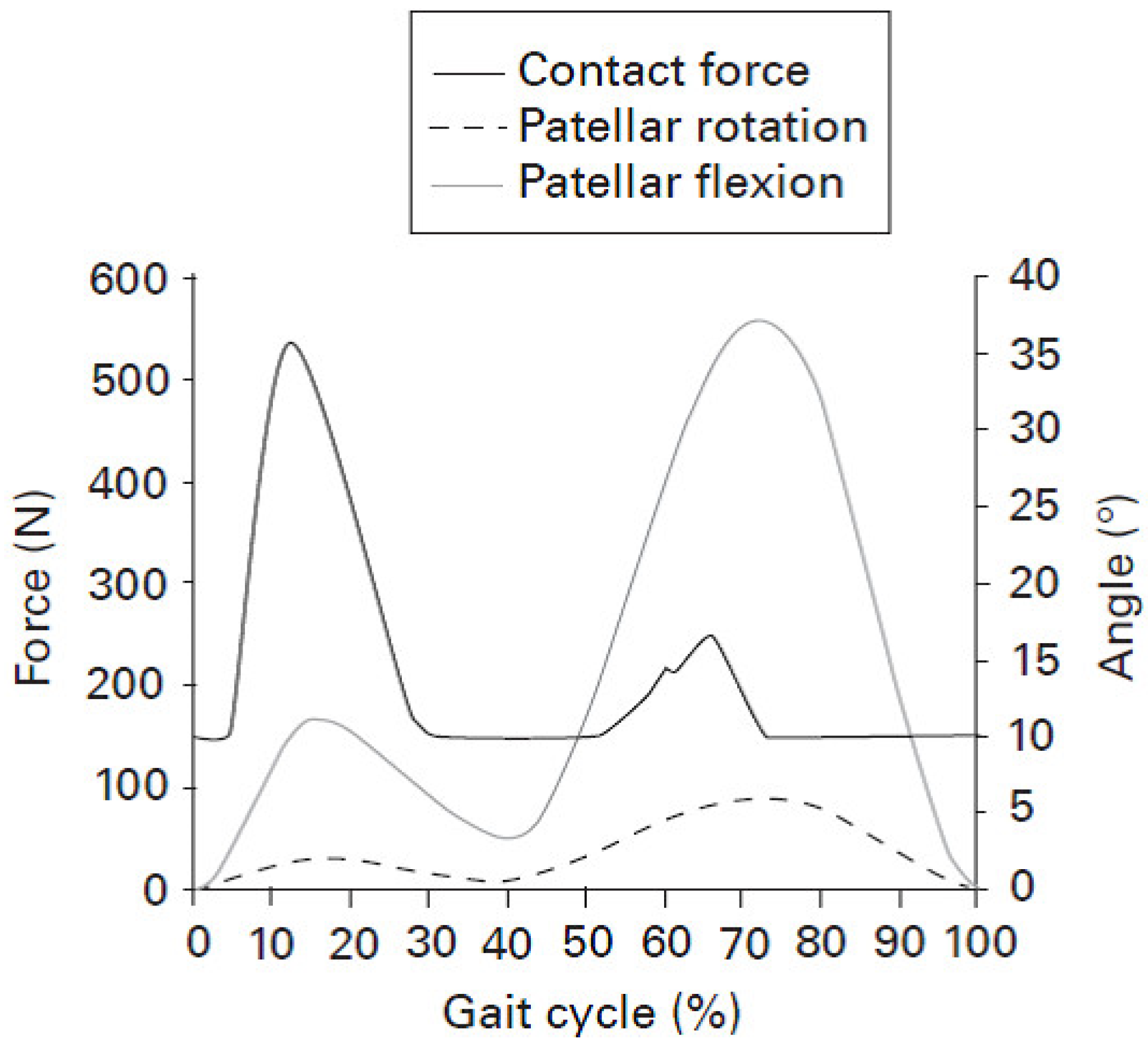
2.6. Numerical Patello-Femoral Wear Test
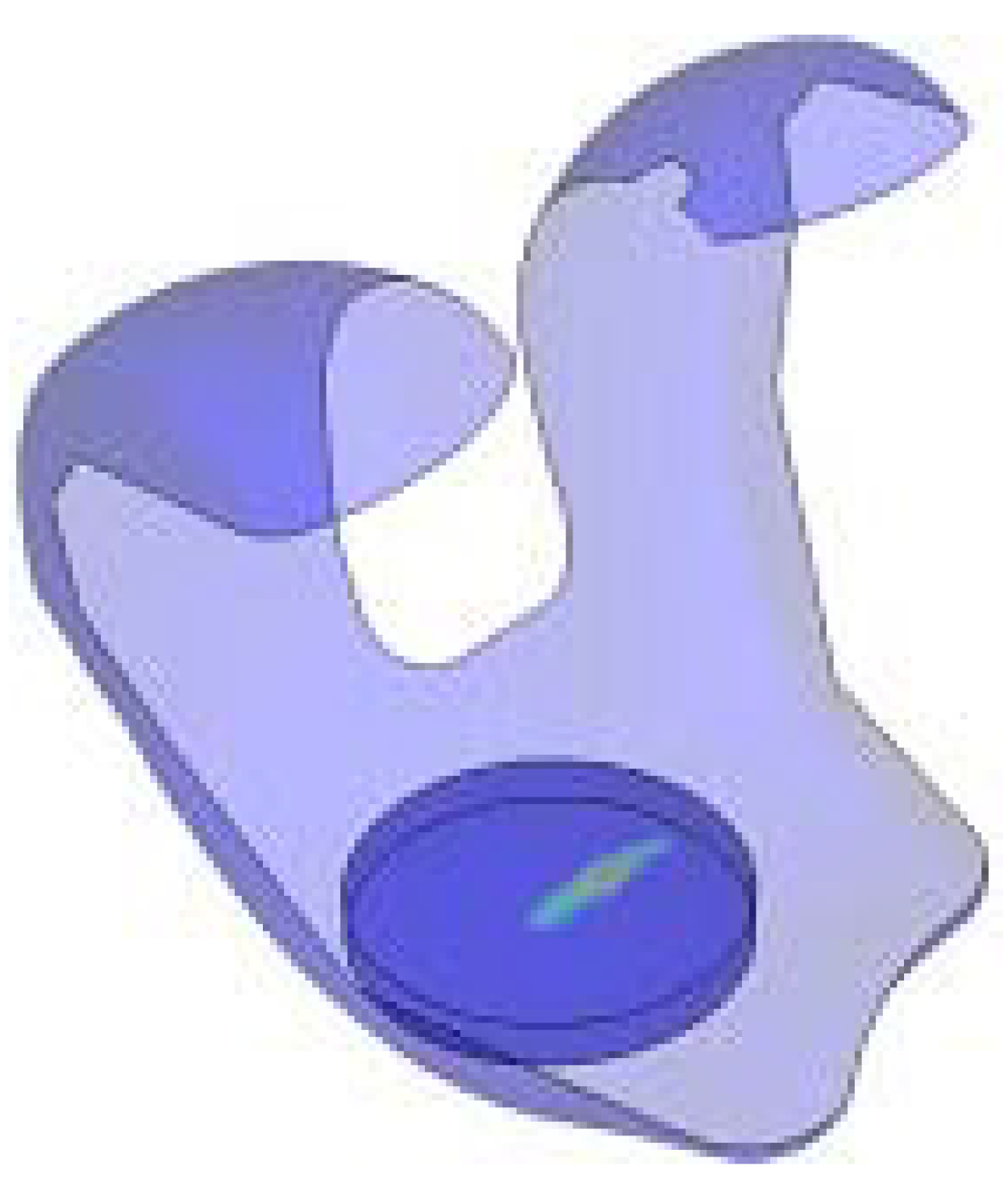
3. Results
3.1. Roll-on-Plane
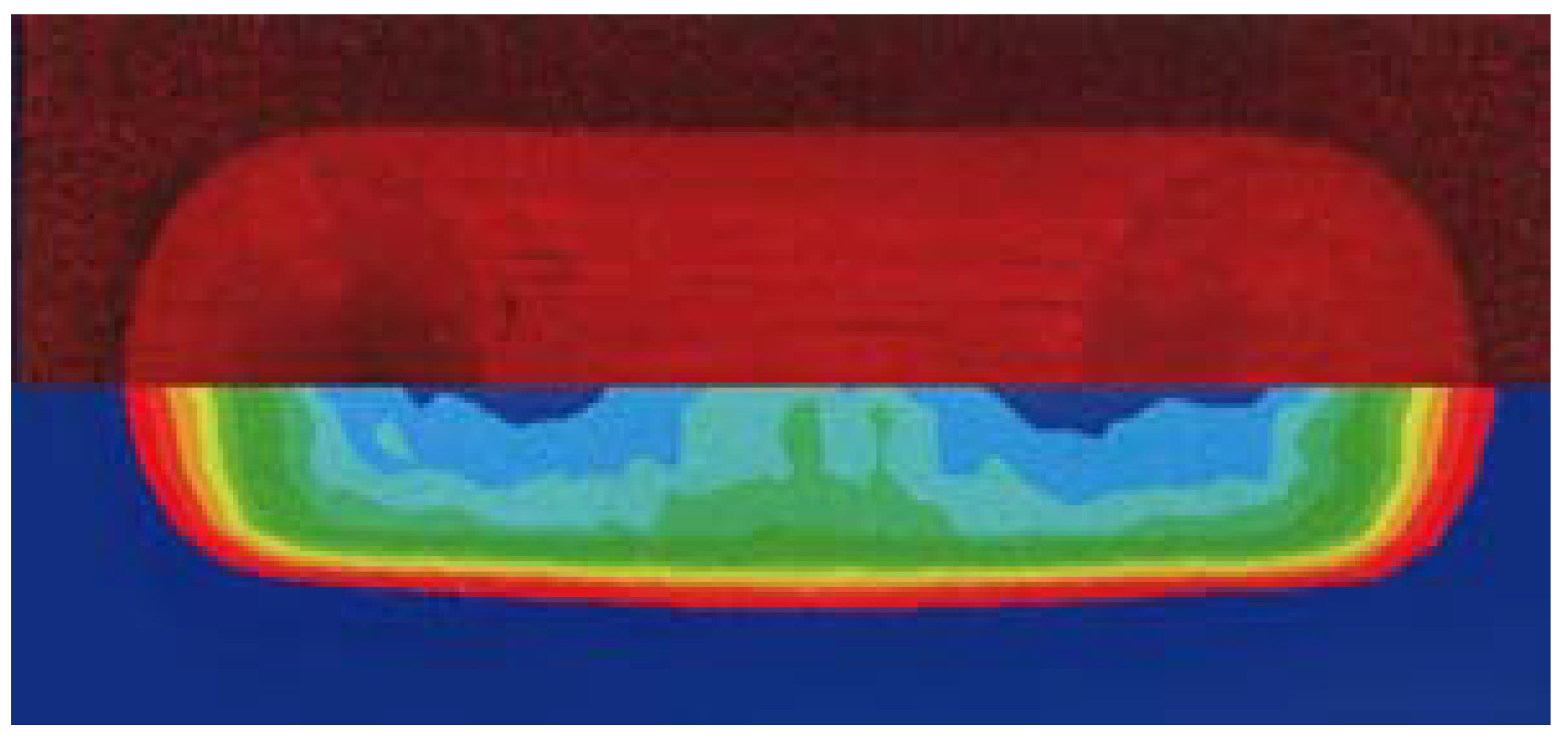
3.2. Patello-femoral Test
4. Discussion
5. Conclusions
Author Contributions
Conflicts of Interest
References
- Charnley, J. Tissue reactions to polytetrafluoroethylene. Lancet (Int.) 1963, 282, 1379. [Google Scholar]
- Wang, A. A unified theory of wear for ultra-high molecular weight polyethylene in multidirectional sliding. Wear 2001, 248, 38–47. [Google Scholar] [CrossRef]
- Johanson, N.A.; Kleinbart, F.A.; Cerynik, D.L.; Brey, J.M.; Ong, K.L.; Kurtz, S.M. Temporal relationship between knee arthroscopy and arthroplasty. A quality measure for joint care? J. Arthroplast. 2011, 26, 187–191. [Google Scholar]
- Curtin, B.; Malkani, A.; Lau, E.; Kurtz, S.; Ong, K. Revision after total knee arthroplasty and unicompartmental knee arthroplasty in the Medicare population. J. Arthroplast. 2012, 27, 1480–1486. [Google Scholar] [CrossRef]
- Blunt, L.; Bills, P.; Jiang, X.; Hardaker, C.; Chakrabarty, G. The role of tribology and metrology in the latest development of bio-materials. Wear 2009, 266, 424–431. [Google Scholar] [CrossRef]
- Matsoukas, G.; Willing, R.; Kim, I.Y. Total hip wear assessment: A comparison between computational and in vitro wear assessment techniques using ISO 14242 loading and kinematics. J. Biomech. Eng. 2009, 131, 1–11. [Google Scholar]
- Punt, I.M.; Cleutjens, J.P.M.; de Bruin, T.; Willems, P.C.; Kurtz, S.M.; van Rhijn, L.W.; Schurink, W.H.; van Ooij, A. Periprosthetic tissue reactions observed at revision of total intervertebral disc arthroplasty. Biomaterials 2009, 30, 2079–2084. [Google Scholar] [CrossRef] [PubMed]
- Wroblewski, B.M.; Fleming, P.A.; Siney, P.D. Charnley low-frictional torque arthroplasty of the hip: 20- to 30-year results. J. Bone Jt. Surg. (Br.) 2009, 81, 427–430. [Google Scholar] [CrossRef]
- Sharkey, P.F.; Hozack, W.J.; Rothman, R.H.; Shastri, S.; Jacoby, S.M. Why are total knee arthroplasties failing today? Clin. Orthop. Relat. Res. 2002, 404, 7–13. [Google Scholar] [CrossRef]
- Rand, J.A.; Trousdale, R.T.; Ilstrup, D.M.; Harmsen, W.S. Factors affecting the durability of primary total knee prostheses. J. Jt. Surg. Am. 2003, 85, 259–265. [Google Scholar]
- Kilgour, A.; Elfick, A. Influence of crosslinked polyethylene structure on wear of joint replacements. Tribol. Int. 2009, 42, 1582–1594. [Google Scholar] [CrossRef]
- Carr, B.C.; Goswami, T. Knee implants—Review of models and biomechanics. Mater. Des. 2009, 30, 398–413. [Google Scholar] [CrossRef]
- Wang, A.; Stark, C.; Dumbleton, J.H. Role of cyclic plastic deformation in the wear of UHMWPE acetabular cups. J. Biomed. Mater. Res. 1995, 29, 619–626. [Google Scholar] [CrossRef] [PubMed]
- Wang, A.; Sun, D.C.; Stark, C.; Dumbleton, J.H. Wear mechanisms of UHMWPE in total joint Replacements. Wear 1995, 181–183, 241–249. [Google Scholar] [CrossRef]
- Bartel, D.L.; Bicknell, V.L.; Wright, T.M. The effect of conformity, thickness, and material on stresses in ultra-high molecular weight components for total joint replacement. J. Bone Jt. Surg. Am. 1986, 68, 1041–1051. [Google Scholar]
- Wrona, F.G.; Mayor, M.B.; Collier, J.P.; Jensen, R.E. The correlation between fusion defects and damage in tibial polyethylene bearings. Clin. Orthop. 1994, 299, 92–103. [Google Scholar] [PubMed]
- Blunn, G.W.; Walker, P.S.; Joshi, A.; Hardinge, K. The dominance of cyclic sliding in producing wear in total knee replacements. Clin. Orthop. 1991, 273, 253–260. [Google Scholar] [PubMed]
- Green, T.R.; Fischer, J.; Matthews, L.B.; Stone, M.H. Effect of size and dose on bone resorption activity of macrophages by in vitro clinically relevant ultra high molecular weight polyethylene particles. J. Biomed. Mater. Res. 2000, 53, 490–497. [Google Scholar] [CrossRef] [PubMed]
- Schmalzried, T.P.; Jasty, M.; Rosenberg, A.; Harris, W.H. Polyethylene wear debris and tissue reactions in knee as compared to hip replacement prosthesis. J. Appl. Biomater. 1994, 5, 185–190. [Google Scholar] [CrossRef] [PubMed]
- Bohl, J.R.; Bohl, W.R.; Postak, P.D.; Greenwald, A.S. The Coventry Award. The effects of shelf life on clinical outcome for gamma sterilized polyethylene tibial components. Clin. Orthop. 1999, 367, 28–38. [Google Scholar] [PubMed]
- Fisher, J.; Al-Hajjar, M.; Williams, S.; Jennings, L.M.; Ingham, E. In vitro Measurement of Wear in Joint Replacements: A Stratified Approach for Enhanced Reliability “SAFER” Pre-Clinical Simulation Testing. Semin. Arthroplast. 2012, 23, 286–288. [Google Scholar] [CrossRef]
- McEwena, H.M.J.; Barnetta, P.I.; Bella, C.J.; Farrarb, R.; Augerc, D.D.; Stoned, M.H.; Fisher, J. The influence of design, materials and kinematics on the in vitro wear of total knee replacements. J. Biomech. 2005, 38, 357–365. [Google Scholar] [PubMed]
- Walker, P.S.; Blunn, G.W.; Broome, D.R.; Perry, J.; Watkins, A.; Sathasivam, S.; Dewar, M.E.; Paul, J.P. A knee simulating machine for performance evaluation of total knee replacements. J. Biomech. 1997, 30, 83–89. [Google Scholar] [CrossRef] [PubMed]
- Abdelgaied, A.; Liu, F.; Brockett, C.; Jennings, L.; Fisher, J. Computational wear prediction of artificial knee joints based on a new wear law and formulation. J. Biomech. 2011, 44, 1108–1116. [Google Scholar] [CrossRef] [PubMed]
- Vanbiervliet, J.; Bellemans, J.; Verlinden, C.; Luyckx, J.P.; Labey, L.; Innocenti, B.; Vandenneucker, H. The influence of malrotation and femoral component material on patellofemoral wear during gait. J. Bone Jt. Surg. Br. 2011, 93, 1348–1354. [Google Scholar] [CrossRef]
- Zhao, D.; Sakoda, H.; Sawyer, W.G.; Banks, S.A.; Fregly, B.J. Predicting Knee Replacement Damage in a Simulator Machine Using a Computational Model With a Consistent Wear Factor. J. Biomech. Eng. 2008, 130, 1–10. [Google Scholar] [CrossRef]
- Dunn, A.C.; Steffens, J.G.; Burris, D.L.; Banks, S.A.; Sawyer, W.G. Spatial geometric effects on the friction coefficients of UHMWPE. Wear 2008, 264, 648–653. [Google Scholar] [CrossRef]
- Kang, L.; Galvin, A.L.; Fisher, J.; Jin, Z. Enhanced computational prediction of polyethylene wear in hip joints by incorporating cross-shear and contact pressure in additional to load and sliding distance: Effect of head diameter. J. Biomech. 2009, 42, 912–918. [Google Scholar] [CrossRef] [PubMed]
- Grupp, T.M.; Yue, J.J.; Garcia, R., Jr.; Basson, J.; Schwiesau, J.; Fritz, B.; Blomer, W. Biotribological evaluation of artificial disc arthroplasty devices: Influence of loading and kinematic patterns during in vitro wear simulation. Eur. Spine J. 2009, 18, 98–108. [Google Scholar] [CrossRef] [PubMed]
- Giddings, V.L.; Kurtz, S.M.; Edidin, A.A. Total knee replacement polyethylene stresses during loading in a knee simulator. Trans. ASME 2001, 123, 842–847. [Google Scholar] [CrossRef]
- Ghiglieri, W.A.; Laz, P.J.; Petrella, A.J.; Bushelow, M.; Kaddick, C.; Rullkoetter, P.J. Probabilistic cervical disk wear simulation incorporating cross-shear effects. In Proceedings of the 55th Annual Meeting of the Orthopaedic Research Society, Las Vegas, NV, USA, 22–25 February, 2009.
- Marquez-Barrientos, C.; Banks, S.A.; DesJardins, J.D.; Fregly, B.J. Increased conformity offers diminishing returns for reducing total knee replacement wear. J. Biomech. Eng. 2010. [Google Scholar] [CrossRef]
- Schwenke, T.; Orozco, D.; Schneider, E.; Wimmer, M.A. Differences in wear between load and displacement control tested total knee replacements. Wear 2009, 267, 757–762. [Google Scholar] [CrossRef]
- Bei, Y.; Fregly, B.J.; Sawyer, W.G.; Banks, S.A.; Kim, N.H. The Relationship between contact pressure, insert thickness, and mild wear in total knee replacements. Comput. Model. Eng. Sci. 2004, 6, 145–152. [Google Scholar]
- Turell, M.; Wang, A.; Bellare, A. Quantification of the effect of cross-path motion on the wear rate of ultra-high molecular weight polyethylene. Wear 2003, 255, 1034–1039. [Google Scholar] [CrossRef]
- Kang, L.; Galvin, A.L.; Brown, T.D.; Fisher, J.; Jin, Z.M. Wear simulation of UHMWPE hip implants by incorporating the effects of cross-shear and contact pressure. Proc. Inst. Mech. Eng. 2008, 222, 1049–1064. [Google Scholar] [CrossRef]
- Fregly, B.J.; Sawyer, G.W.; Harman, M.K.; Banks, S.A. Computational wear prediciton of a total knee replacement from in vivo kinematics. J. Biomech. 2005, 38, 305–314. [Google Scholar] [CrossRef] [PubMed]
- Walker, P.S.; Blunn, G.W.; Perry, J.P.; Bell, C.J.; Sathasivam, S.; Andriacchi, T.P.; Paul, J.P.; Haider, H.; Campbell, P.A. Methodology for long-term wear testing of total knee replacements. Clin. Orthop. Relat. Res. 2000, 372, 290–301. [Google Scholar] [CrossRef] [PubMed]
- Knight, L.A.; Pal, S.; Coleman, J.C.; Bronson, F.; Haider, H.; Levine, D.L.; Taylor, M.; Rullkoetter, P.J. Comparison of long-term numerical and experimental total knee replacement wear during simulated gait loading. J. Biomech. 2007, 47, 1550–1558. [Google Scholar] [CrossRef]
- Ellison, P.; Barton, D.C.; Esler, C.; Shaw, D.L.; Stone, M.H.; Fisher, J. In vitro simulation and quantification of wear within the patellofemoral joint replacement. J. Biomech. 2008, 41, 1407–1416. [Google Scholar] [CrossRef] [PubMed]
- Maiti, R.; Fisher, J.; Rowley, L.; Jennings, L.M. The influence of kinematic conditions and design on the wear of patella-femoral replacements. Proc. Inst. Mech. Eng. H 2014, 228, 175–181. [Google Scholar] [CrossRef] [PubMed]
- Askari, E.; Flores, P.; Dabirrahmani, D.; Appleyard, R. Nonlinear vibration and dynamics of ceramic on ceramic artificial hip joints: A spatial multibody modelling. Nonlinear Dyn. 2014, 76, 1365–1377. [Google Scholar] [CrossRef] [Green Version]
- Askari, E.; Flores, P.; Dabirrahmani, D.; Appleyard, R. Study of the friction-induced vibration and contact mechanics of artificial hip joints. Tribol. Int. 2014, 70, 1–10. [Google Scholar] [CrossRef] [Green Version]
- Archard, J.F. Contact rubbing of flat surfaces. J. Appl. Phys. 1953, 8, 981–988. [Google Scholar] [CrossRef]
- Hegadekattea, V.; Huber, N.; Krafta, O. Modeling and simulation of wear in a pin on disc tribometer. Tribol. Lett. 2006, 24, 51–60. [Google Scholar] [CrossRef]
- Pal, S.; Haider, H.; Laz, P.J.; Knight, L.A.; Rullkoetter, P.J. Probabilistic computational modeling of total knee replacement wear. Wear 2008, 264, 701–707. [Google Scholar] [CrossRef]
- Sarkar, A.D. Friction and Wear; Academic Press: London, UK, 1980. [Google Scholar]
- Halloran, J.P.; Easley, S.K.; Petrella, A.J.; Rullkoetter, P. Comparison of deformable and elastic foundation finite element simulations for predicting knee replacement mechanics. J. Biomech. Eng. 2005, 127, 813–818. [Google Scholar] [CrossRef] [PubMed]
- Saikko, V. In vitro wear simulation on the RandomPOD wear testing system as a screening method for bearing materials intended for total knee arthroplasty. J. Biomech. 2014, 47, 2774–2778. [Google Scholar] [CrossRef] [PubMed]
- Srinivas, G.R.; Deb, A.; Kumar, M.N. A study on polyethylene stresses in mobile-bearing and fixed-bearing total knee arthroplasty (TKA) using explicit finite element analysis. J. Long-Term Eff. Med. Implant. 2013, 23, 275–283. [Google Scholar] [CrossRef]
- Schwiesau, J.; Schilling, C.; Kaddick, C.; Utzschneider, S.; Jansson, V.; Fritz, B.; Blömer, W.; Grupp, T.M. Definition and evaluation of testing scenarios for knee wear simulation under conditions of highly demanding daily activities. Med. Eng. Phys. 2013, 35, 591–600. [Google Scholar] [CrossRef] [PubMed]
- Grupp, T.M.; Saleh, K.J.; Mihalko, W.M.; Hintner, M.; Fritz, B.; Schilling, C.; Schwiesau, J.; Kaddick, C. Effect of anterior-posterior and internal-external motion restraint during knee wear simulation on a posterior stabilised knee design. J. Biomech. 2013, 46, 491–497. [Google Scholar] [CrossRef] [PubMed]
© 2014 by the authors; licensee MDPI, Basel, Switzerland. This article is an open access article distributed under the terms and conditions of the Creative Commons Attribution license (http://creativecommons.org/licenses/by/4.0/).
Share and Cite
Innocenti, B.; Labey, L.; Kamali, A.; Pascale, W.; Pianigiani, S. Development and Validation of a Wear Model to Predict Polyethylene Wear in a Total Knee Arthroplasty: A Finite Element Analysis. Lubricants 2014, 2, 193-205. https://doi.org/10.3390/lubricants2040193
Innocenti B, Labey L, Kamali A, Pascale W, Pianigiani S. Development and Validation of a Wear Model to Predict Polyethylene Wear in a Total Knee Arthroplasty: A Finite Element Analysis. Lubricants. 2014; 2(4):193-205. https://doi.org/10.3390/lubricants2040193
Chicago/Turabian StyleInnocenti, Bernardo, Luc Labey, Amir Kamali, Walter Pascale, and Silvia Pianigiani. 2014. "Development and Validation of a Wear Model to Predict Polyethylene Wear in a Total Knee Arthroplasty: A Finite Element Analysis" Lubricants 2, no. 4: 193-205. https://doi.org/10.3390/lubricants2040193



